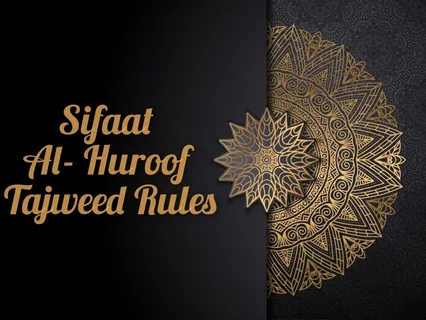“Sifaat Al Huroof” (صفات الحروف) are the specific characteristics or attributes of the Arabic letters that are essential to observe correctly in Tajweed, the art of Quranic recitation. Understanding and applying Sifaat Al Huroof in Tajweed ensures the proper pronunciation of letters, resulting in beautiful, clear, and accurate recitation of the Quran.
Sifaat Al Huroof in Tajweed
Tajweed is the set of rules governing the correct pronunciation and articulation of the Arabic letters when reciting the Quran. Each Arabic letter has unique characteristics that distinguish it from other letters. These characteristics, known as Sifaat Al Huroof, are crucial to mastering Tajweed as they affect pronunciation, emphasis, softness, and the overall sound of the letters.
These attributes are not just phonetic; they also carry spiritual and linguistic significance because improper Arabic pronunciation can change the meaning of the Quranic text. Tajweed helps preserve the Quran’s original integrity by teaching how to apply these characteristics when reciting.
Types of Sifaat Al Huroof
The Sifaat Al Huroof are divided into three main categories:
-
Sifaat al-Ḍamārah (Intrinsic or Essential Characteristics)
-
Sifaat al-Ḍiyāfah (Qualities due to Letter Interaction)
-
Sifaat al-Muhālahah (Opposing or Contrasting Characteristics)
Each of these groups contains various traits that help define the correct articulation of every Arabic letter.
Sifaat al-Ḍamārah (Fundamental Qualities)
These are the essential, inherent characteristics that are present in every letter or in specific groups of letters. They do not change regardless of the letters beside them.
-
Hams (Whispered Voice): Letters with Hams are pronounced softly with a breathy whisper sound and without vocal cord vibration. Letters that have Hams include: (ت, ث, ف, ح, س, ش, خ, ص, ك).
Hams letters produce an airy sound, almost like a sigh or whisper. -
Jahr (Voiced Letters): Jahri letters are pronounced with full voice and vocal cord vibration. Letters like (ب, ج, د, ذ, ز, ر, ض, غ, ع, ل, م, ن, و, ي, ه, أ) are Jahri.
-
Shiddah (Strength or Emphasis): These letters are pronounced with strength and firmness from the articulation point, causing a heavier or more forceful sound. Examples: (ط, ق, ص, ض, ظ, غ).
-
Rakhawah (Softness or Laxity): Opposite of Shiddah, these letters are pronounced softly without tension. Letters: (ب, ج, د, ذ, ز, ر, س, ش, ض).
-
Isti’laa (Elevation): Letters pronounced with the tongue raised towards the palate, producing a heavy and exalted sound. These are the “heavy” letters: (خ, ص, ض, ط, ظ, غ, ق).
-
Istifāl (Lowering); Opposite of Isti’laa, these letters are pronounced with the tongue kept low, producing a lighter sound. They include: (ب, ج, د, س, ص, ض, ف, ك, ل, م, ن, ه, و, ي).
-
Tafkheem (Thickening or Heavy Sound): Some letters, like the letter “ق” and “ط,” require a thick, heavy tone in pronunciation that resonates deeply.
-
Tarqeeq (Thin or Light Sound): Many letters are pronounced thinly to allow easy, smooth recitation, such as (ء, ب, ت, س, ش, ك).
Sifaat al-Ḍiyāfah (Arising from Letter-Letter Interaction)

These characteristics appear when letters affect each other’s sound during recitation.
-
Iqlab (Conversion): This occurs when one letter converts into another similar letter, such as ن accompanied by ب changing to م (Example in “من بعد”).
-
Idgham (Merging): One letter merges into the next, often observed in Noon Saakinah and Tanween cases, producing a nasalized sound.
-
Ikhfa’ (Concealment): Noon Saakinah or Tanween is pronounced while merging the sound softly between Idgham and Iqfa, creating a hidden sound effect before the next letter.
-
Izhar (Clear Pronunciation): Letters are pronounced clearly without merging, especially Noon Saakinah and Tanween when followed by throat letters.
Sifaat al-Muhālahah (Opposing Characteristics)
Some letters’ attributes oppose each other and are useful when learning the proper articulation.
-
Shiddah vs. Rakhawah: A letter is either strong (Shiddah) or soft (Rakhawah) but cannot be both simultaneously.
-
Tafkheem vs. Tarqeeq: Letters are either pronounced with thickness (Tafkheem) or thinly (Tarqeeq).
Understanding these principles helps the reciter differentiate between letters and pronounce them correctly.
How Sifaat Al Huroof Affect Tajweed Application
-
Accuracy: Knowing Sifaat Al Huroof ensures each letter’s correct articulation point (Makhraj Huruf) and characteristic, preserving the meaning of the Quranic words.
-
Beautification: Correct use of heavy and light tones, softness and strength creates melodious, pleasing recitation.
-
Clearing Confusion: Some letters are similar, and their unique Sifaat help distinguish them when reciting.
Examples of Sifaat in Quranic Recitation
-
The letter “ق” (Qaf) is a letter of Isti’laa and must be recited with a raised tongue and heavy sound.
-
The letter “ب” (Ba) is a light letter with Tarqeeq and softness (Rakhawah).
-
The rules of Idgham occur with Noon Saakinah merging into the following letters with nasalization.
-
Izhar is applied clearly in words like “منه” where Noon Saakinah is followed by the letter “هـ”.
These examples are part of the core Tajweed practice where Sifaat Al Huroof are applied.
Practical Tips to Master Sifaat Al Huroof
-
Learn the Makharij (Articulation Points) first since Sifaat depend on the correct articulation of letters.
-
Listen to Qualified Reciters who correctly apply Sifaat and imitate their pronunciation.
-
Practice with Tajweed Teachers who provide feedback on letter quality and sound attributes.
-
Use Audio-Visual Materials that explain the characteristics with examples.
-
Repeat and Review, as Tajweed is a skill perfected over time through consistent practice.
FAQs
What are Sifaat Al Huroof in Tajweed?
They are the characteristic traits of Arabic letters that affect their sound and pronunciation in Quranic recitation.
Why are Sifaat Al Huroof important for Tajweed?
They ensure correct and precise pronunciation, which maintains the meaning and beauty of the Quran.
How many types of Sifaat Al Huroof are there?
There are three main categories: essential characteristics (Ḍamārah), characteristics due to letter interaction (Ḍiyāfah), and opposing characteristics (Muhālahah).
Can Sifaat Al Huroof change the meaning of a word?
Yes, incorrect application of letter traits can alter a word’s sound and consequently its meaning.
How can I best learn Sifaat Al Huroof?
Practice with knowledgeable teachers, listen to expert reciters, and use Tajweed audio-visual resources focusing on letter traits and articulation.
Conclusion
Sifaat Al Huroof are foundational to Tajweed as they describe the intrinsic and context-driven characteristics that define the precise articulation of Arabic letters. Mastery of these traits leads to accurate, beautiful, and meaningful Quranic recitation, preserving the sacred text’s intended pronunciation and meaning. By understanding and practicing the various qualities such as softness, strength, elevation, and clarity, reciters can achieve a high standard of Tajweed, honoring the Quran and enriching the spiritual experience of its recitation.

